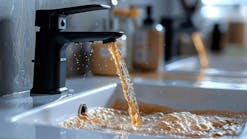Rainwater catchment systems are water collection systems that harvest rainwater at the first point of contact from rainfall. These systems can be used for irrigation and, when designed and evaluated properly, are suitable for drinking water usage. Catchment systems vary from rooftop coatings and liners to gutters and more. For example, a catchment system may include a rooftop coating and gutters that allow rainwater to flow to the final collection point. In the past few years, rain barrels have become increasingly popular with homeowners as a way to live a more sustainable lifestyle.
The benefits of collecting rainwater extend beyond a homeowner utilizing a rain barrel for irrigation. Long before modern drinking water facilities were developed, rainwater catchment was used to collect drinking water. Today, many areas of the world still rely heavily on rainwater catchment systems to meet drinking water needs. For this reason, it is important to ensure these systems and their components do not leach contaminants into the drinking water supply. With certification to NSF Protocol P151: Health Effects from Rainwater Catchment System Components, manufacturers can be sure their products do not impart contaminants into water at levels that exceed the U.S. Environmental Protection Agency’s (EPA) drinking water regulations or advisories.
Rainwater catchment can serve as a primary or alternative source of potable water. In areas where access to water is limited or water supplies are scarce, rainwater catchment is a viable and sustainable solution. As households and businesses become more informed of the benefits of sustainable living, the desire for quality rainwater catchment options has increased. Products certified to NSF Protocol P151 have been thoroughly evaluated for use in these systems.
NSF Protocol P151 establishes minimum requirements for components used in rainwater catchment systems. Certification to this protocol assures consumers that:
- The system does not add anything harmful to the water.
- The instructions or literature are not misleading.
- The product materials and manufacturing process are evaluated on an ongoing basis.
NSF Protocol P151 does not evaluate the quality of the rainwater or its acceptability for use as drinking water. This is left to the appropriate regulatory agency with authority.
Rainwater Catchment Protocol Overview
NSF Protocol P151 was developed to assess and evaluate the concentration of contaminants extracted from surfaces and components exposed to rainwater. The protocol covers materials that are placed on rooftops or ground surfaces that come in direct contact with rainwater, including gutters, barrier materials and catchment surfaces, such as coatings, paints and liners. Evaluation to this protocol includes a technical review of formulary information for the material along with published instructions, product testing and an audit of the production facility.
The formulation review entails a detailed analysis of each material or ingredient used to produce the component. Careful assessment of the formulation allows for the evaluation of the ingredients against EPA guidelines. The formulation review also allows for the determination of the appropriate chemical extraction testing of the component. As part of the review, the manufacturer must supply written instructions that specify the end use for the product. For field-applied products, the instructions must include preparation, application and installation information.
Product Testing Criteria
Product testing for NSF Protocol P151 consists of chemical extraction testing of the material, performed on the non-weathered and weathered materials. The component is weathered utilizing an accelerated outdoor weather procedure in accordance with American Society of Testing and Materials procedures, as shown in Table 1. The weathering procedure and subsequent chemical extraction are performed to ensure that the materials or components will not extract chemicals at unsafe levels in varied environmental conditions. Samples undergo accelerated outdoor weathering until they reach the required amount of cumulative radiation, 189 megajoules per sq meter.
Chemical extraction testing is performed on water collected from the sample exposure. The exposure is performed in reagent water without chlorine at 25°C and with a maximum total organic carbon level of 100 μg/L. Collected water then is tested for contaminants. The laboratory data from the analysis are normalized based on the end use for the product and evaluated against the criteria levels for each contaminant. The passing criteria are based on limits established by EPA drinking water regulations or advisories.
Other Certification Criteria
Aside from the formulary and published instructions review, along with product testing, certification to NSF Protocol P151 also requires a five-year retest and production location audits. Production audits are used to confirm the material is being manufactured in accordance with the policies of the protocol and periodic monitor testing ensures compliance to the criteria established by EPA drinking water regulations or advisories.
Manufacturers and consumers can be assured that products certified to NSF Protocol P151 have met the requirements for safe use with rainwater for drinking water applications.



